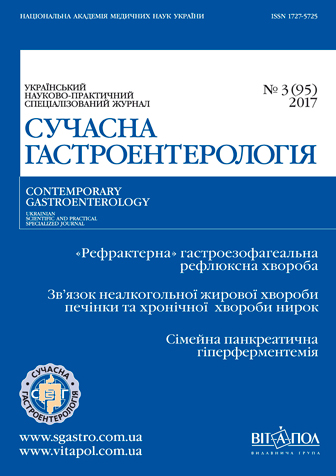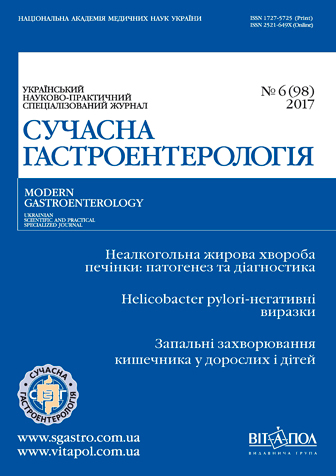- Issues
- About the Journal
- News
- Cooperation
- Contact Info
Issue. Articles
¹3(95) // 2017

1. Original researches
|
Notice: Undefined index: pict in /home/vitapol/sgastro.vitapol.com.ua/en/svizhij_nomer.php on line 74 The predictors of early fibrosis diagnosis at the combined course of chronic viral hepatitis C and non-alcoholic fatty liver diseaseO. M. Bilovol, L. R. BobronnikovaKharkiv National Medical University |
|---|
Materials and methods. Investigation involved 79 patients (32 men and 47 women), the mean age (54.5 ± 3.2) years. The patients were divided into two groups: the 1st group (n = 45) with non-alcoholic steatohepatitis(NASH), the 2nd group (n = 34) with the concomitant CVH-C and NASH. The control group (n = 20) consisted of age- and sex-matching subjects. The following investigation were performed: general clinical examinations, FibroMax test, fibroelastography (FibroScan). The calculation were performed using the patented algorithm (BioPredictive, France). The obtained quantitative indicators were evaluated by the METAVIRsystem.
Results. In the 1st group, indicators of fibrosis formation corresponded to the F1 stage in 25 % (portal fibrosis without creation of the septs with minimal histological activity (À1)), to the F21 stage in 44.2 %(portal fibrosis with the presence of single septs with moderate activity(À2)), and F3 stage in 30.8 % of patients (fibrosis with the presence of multiple portocentral septs without cirrhosis with high histologicalactivity(À3)). In the 2nd group these numbers were 10.4, 27, and 36.3 % of patients. The F4 (À3) stage was reveled in 26.4 % patients of the 2nd group. The correlation has been established between the degree of activity of inflammation and fibrosis severity in the liver (r = +0.54; p < 0.05). The fibroelastographyin the first group demonstrated the following: the mean density of liver parenchyma was (6.4 ± 1.3) kPa (F1, À1) in 25.0 % patients, (8.5 ± 2.2) kPa (F2, À2) in 44.2 %; (10.8 ± 2.9) kPa (F3, À3) in 30.8 %,; in the 2nd group the values of (7.2 ± 1.4) kPa (F1, À1) in 10.4 % patients; (9.3 ± 1.2) kPa (F2, À2) in 27.9 %; (12.2 ± 3.3) kPa (F3, À3) in 36.3 %, (18.5 ± 0.8) kPa(F4, À3) in 26.4 %. Correlation has been established between the density of liver parenchyma and fibrosis severity (r = +0.54; p < 0.05).
Conclusions. With the help of the combined diagnosis strategy of the using of FibroMax test and fibroelastography it has been established that the combined course of CVH-C and NASHwas accompanied with the progression of the liver inflammation, steatosis, fibrosis and cirrhosis. The use of FibroMax test and FibroScan improved the early diagnosis of the progression of liver fibrosis and cirrhosis in patients with CVH-C and NASH, thus allow the evaluating of the risk of the combined pathology progression and development of complications, as well as to choose the effective and timely therapeutic tactics.
Keywords: chronic hepatitis C, non-alcoholic non-alcoholic steatohepatitis, FibroMax, fibroelastography, liver fibrosis, Liver cirrhosis.
![]() To download
To download
full version need login
Original language: Russian
2. Original researches
|
Notice: Undefined index: pict in /home/vitapol/sgastro.vitapol.com.ua/en/svizhij_nomer.php on line 74 The assessment of the contribution of polymorphic variants of the endothelial NO-synthase gene to the formation of gastroesophageal reflux disease with concomitant obesityL. M. PasiyeshviliKharkiv National Medical University |
|---|
Materials and methods. Investigation involved 43 patients with GERD and concomitant obesity (the main group) and 36 patients with isolated GERD (comparison group). The clinical, laboratory and instrumental methods of investigation were used. Endothelial function was assessed with the conduction of DNA-diagnosis of the polymorphism C/T Ò-786Ñ gene promoter of the eNOS.
Results. DNA-diagnosis with the investigation of insertion-deletion polymorphism eNOS gene resulted in the establishing of the alleles redistribution in the main group of patients with prevalence of pathological genotype SS (in 48.8 %). At the GERD and obesity comorbidity, the number of gene mutations increased in more than 8 times. With this, clinical manifestations were characterized by more prolonged exacerbation period (1.5 — 2.0 months), low efficacy of the therapy, variable complexes of symptoms and intensive gastroesophageal reflux. The increased arterial pressure (51.2 %), cardialgias (44.2 %), arrhythmias (20.9 %) were often observed in the periods of the disease exacerbation. Patients with the combined GERD and obesity and CC genotype had the elevated risk of not only GERD development, but also the manifestations of cardiac symptoms. The carriers of TT genotype had the low risk of GERD development and formation of the extra-esophageal complications.
Conclusions. At the comorbidity of GERD and obesity, the significant increase (48.8 %) of the pathological polymorphic variants of eNOS gene, that allows expecting the increased risk of endothelial and haemostatic disorders in this group of patients. The increased risk of developing of the non-esophageal cardiac symptoms has been established against the background of the pathological CC homozygotes of eNOS gene, which may be a consequence of the development of endothelial dysfunction and tissue hypoxia risk.
Keywords: gastroesophageal reflux disease, obesity, pathogenesis, polymorphism of endothelial NO-synthase gene.
![]() To download
To download
full version need login
Original language: Ukrainian
3. Original researches
|
Notice: Undefined index: pict in /home/vitapol/sgastro.vitapol.com.ua/en/svizhij_nomer.php on line 74 Influence of nonalcoholic fatty liver disease on the renal function in patients with hypertensionK. O. Prosolenko, V. I. Molodan, K. O. SytnykKharkiv National Medical University |
|---|
Materials and methods. The study involved group of 88 patients with NAFLD and EH II stage, second grade. The following was investigated: anthropometric parameters, office blood pressure (BP), parameters of carbohydrate and lipid metabolism, inflammatory activity, adiponektyn, insulin resistance (IR), liver biochemical tests, glomerular filtration rate (GFR), microalbuminuria (MAU), ultrasound of the liver.
Results. Chronic kidney disease (CKD) was significantly more common in patients with the liver steatosis of III degree. The degree of hepatic steatosis was associated with impaired renal function. The state of lipid metabolism, inflammation level, the degree of IP and hypertension depends on the state of renal function. The systolic blood pressure, hypertriglyceridemia, IR, pro-inflammatory status, increased gamma glutamyltranspeptidase levels are the most important factors, associating with the renal dysfunction in patients with NAFLD and EH.
Conclusions. The NAFLD and EH comorbidity is associated with risk of the chronic kidney disease developing.
Keywords: nonalcoholic fatty liver disease, kidney function, hypertension, influence, comorbidity.
![]() To download
To download
full version need login
Original language: Ukrainian
4. Original researches
|
Notice: Undefined index: pict in /home/vitapol/sgastro.vitapol.com.ua/en/svizhij_nomer.php on line 74 The apelin levels in the blood serum of the liquidators of the accident at the Chernobyl NPP with essential hypertension and essential hypertension combined with the gastroesophageal reflux disease, in the dynamics of treatmentV. P. SinelnikKharkiv Medical Academy of Postgraduate Education |
|---|
Materials and methods. The investigation involved 105 liquidators of the ChNPP accident aged 46 to 71 years (mean age — 57.5 ± 0.8 years), male patients prevailed among the investigated (89 (84.8 %). All patients were divided into two groups: the first group included 53 patients with EH, in the second 52 patients with EH combined with GERD. Each group was divided on sub-groups depending on the therapy assigned: subgroups 1À (23 men and 4 women) and 2À (22 men and 4 women) received the standard therapy, patients of subgroups 1B (22 men and 4 women) and 2B (22 men and 4 women) in additional to the standard treatment received Actovegin in a dose of 200 mg i. v. The control group consisted of 20 practically healthy subject, age- and sex-matching to the patients of the 1st and 2nd groups. The serum apelin levels were measured with immune enzymatic method at baseline and 3 months after the treatment. All patients were investigated and treated in the hospital, the Therapeutic departments of the Kharkiv Regional Clinical Specialized dispensary of radiation protection of the population during the year 2016.
Results. The apelin levels in the blood serum of control group was significantly lower than in patients with EH and EH combined with GERD both in general and as sex-dependent indices. In EH patients, 3 months of standard treatment resulted in the slight, but not significant (ð > 0.05) reduction of the investigated index in comparison with the baseline value. In patients with EH, who received additional Actovegin, the mean apelin levels significantly decreased after 3 moths of treatment (ð ≤ 0.001). In patients with EH and concomitant GERD, the mean apelin levels significantly decreased vs the baseline values after both standard treatment and therapy with Actovegin addition.
Conclusions. Actovegin additional to the standard treatment scheme resulted in the significant reduction of apelin levels both in patients with EH and EH and concomitant GERD.
Keywords: liquidators of the accident at the Chernobyl NPP, essential hypertension, gastroesophageal reflux disease, apelin.
![]() To download
To download
full version need login
Original language: Ukrainian
5. MEDICINES
|
Notice: Undefined index: pict in /home/vitapol/sgastro.vitapol.com.ua/en/svizhij_nomer.php on line 74 Clinical dilemmas of non-alcoholic and alcoholic fatty liver diseaseO. V. KolesnikovaSI «L. T. Mala National Therapy Institute of NAMS of Ukraine», Kharkiv |
|---|
Keywords: non-alcoholic fatty liver disease, alcoholic liver disease, alcohol doses, protective effect of alcohol, Betargin.
![]() To download
To download
full version need login
Original language: Russian
6. MEDICINES
|
Notice: Undefined index: pict in /home/vitapol/sgastro.vitapol.com.ua/en/svizhij_nomer.php on line 74 The experience of the use of multicomponent probiotic Vivocaps 16 at the irritable bowel syndromeG. D. Fadieienko, O. Ye. GridnevSI «L. T. Mala National Therapy Institute of NAMS of Ukraine», Kharkiv |
|---|
Materials and methods. The investigation involved 40 patients with the IBS. The patients were divided into two groups: group 1 consisted of 20 patients with IBS-D, and group 2 included 20 patients with IBS-C. The algorithm of examination included assessment of clinical, laboratory and instrumental methods. Diagnosis of IBS was based on IV Rome criteria. Level of total IgA was detected with ELISA test using «IgA total — ELISA Best».
Results. It has been established, that the use of multicomponent probiotic Vivocaps 16 promoted the improvement of abdominal pain, dyspeptic disorders, stool consistency in all groups. The significant increase of the level of total IgA (p < 0.05) have been revealed in patients with IBS-C, IBS-D.
Conclusions. In patients with IBS-C, IBS-D it is advisable to prescribe multicomponent probiotic Vivocaps 16.
Keywords: multicomponent probiotics, Vivocaps 16, IBS, intestinal microbiota.
![]() To download
To download
full version need login
Original language: Russian
7. MEDICINES
|
Notice: Undefined index: pict in /home/vitapol/sgastro.vitapol.com.ua/en/svizhij_nomer.php on line 74 Pregnancy in patients with inflammatory bowel disease. The specific features of treatmentA. E. Dorofeev, M. M. RudenkoO. O. Bogomolets National Medical University, Kyiv |
|---|
Keywords: nonspecific ulcerative colitis, Crohn’s disease, pregnancy, mesalazine.
![]() To download
To download
full version need login
Original language: Russian
8. MEDICINES
|
Notice: Undefined index: pict in /home/vitapol/sgastro.vitapol.com.ua/en/svizhij_nomer.php on line 74 The biliary sludge therapy: the clinical efficacy increasing of the ursodeoxycholic acid in combination with lactuloseM. B. Shcherbynina 1, T. M. Shevchenko 1, M. V. Patratiy 2, N. P. Dementiy 31 Oles Honchar Dnipro National University |
|---|
Materials and methods. The observations involved 59 patients with BS (25 men and 34 women, the mean age 22.1 ± 4.5 years). The patients were divided into two groups. The course of 6 weeks therapy for the first group (n = 31) included Ursochol in a dose of 10 mg/kg/day; and patients of the second group (n = 28) were treated with the combination of the same Ursochol dose and lactulose in a dose of 30 ml/day. Patients were examined at beasile and after the treatment. Clinical efficacy the therapy schemes were assessed based on the dynamics of complaints, complex changes of liver and cholesterol, results of fecal seeding intestinal microbiota, ultrasound data and the status of the biliary system.
Results. The study involved patients with a tendency to constipation (42 subjects — 71.2 %), flatulence (35 patients 59.3 %), with a BS in microlithiasis without visual changes of the gallbladder (GB) wall, with the increased liver echo density (28 subjects, 47.5 %), GB dysfunction of hypokinetic type and hypertonicity of the Oddi sphincter (40 subjects, 67.8 %). The performance results sowing feces corresponded to the dysbiosis of 1 and 2 degrees, respectively, in 36 (61 %) and 23 (39 %) persons and directly correlated with a tendency to constipation (r = 0.51, p < 0.05) and bloating symptoms (r = 0.75, p < 0.05). Against the background of therapy, the positive dynamics of clinical picture and the indicators studied was attained in both groups. The tolerability of both treatment schemes was assessed by the patients as good.
Conclusions. In the patients with BS in a form of microlithiasis, the changes in intestinal microbiota were accompanied with a tendency to constipation, bloating and changes of biliary kinetics. Six weeks of therapy with Ursohol® in a dose of 10 mg/kg/day in combination with lactulose at a dose of 30 ml/day promoted the more pronounced effects on the clinical manifestations’ eliminating and recovery indicators. Ursohol® monotherapy resulted in the effective BS removal in 67.7 % of cases. The combination therapy with Ursohol® and lactulose showed 89.3 % efficiency, giving the rationale for the combined use of these agents as an optional litholytic scheme. Given the conservation of BS in the number of patients during treatment, medication orientation to its detection and removal should be more active.
Keywords: biliary sludge, dysfunctional biliary disorders, ursodeoxycholic acid, Ursohol®, lactulose.
![]() To download
To download
full version need login
Original language: Russian
9. CLINICAL CASE
|
Notice: Undefined index: pict in /home/vitapol/sgastro.vitapol.com.ua/en/svizhij_nomer.php on line 74 Family benign pancreatic hyperenzymemia: what do we know about it and what should doctors do?O. Yu. Gubska, T. S. AlianovaO. O. Bogomolets National Medical University, Kyiv |
|---|
Keywords: family benign pancreatic hyperenzymemia, Gullo’s syndrome, blood serum alpha-amylase, urinary alpha-amylase, pancreatic amylase, lipase, trypsin.
![]() To download
To download
full version need login
Original language: Ukrainian
10. Reviews
|
Notice: Undefined index: pict in /home/vitapol/sgastro.vitapol.com.ua/en/svizhij_nomer.php on line 74 The refractory gastroesophageal reflux disease: the state of the problemV. I. Vdovichenko 1, A. V. Ostroglyad 21 Danylo Halytskiy Lviv National Medical University |
|---|
Keywords: gastroesophageal reflux disease, therapy refractoriness, reasons, prevalence, variants of treatment.
![]() To download
To download
full version need login
Original language: Ukrainian
11. Reviews
|
Notice: Undefined index: pict in /home/vitapol/sgastro.vitapol.com.ua/en/svizhij_nomer.php on line 74 Nonalcoholic fatty liver disease and chronic kidney disease: some mechanisms of their relationshipV. A. ChernyshovSI «L. T. Mala National Therapy Institute of NAMS of Ukraine», Kharkiv |
|---|
Keywords: hepatic steatosis, kidney dysfunction, a relationship, common mechanisms.
![]() To download
To download
full version need login
Original language: Russian
Current Issue Highlights
¹6(98) // 2017

Chronic inflammatory bowel disease and viral infections
E. I. Sergienko
The phenomenon of Helicobacter pylori-negative ulcer and its place in clinical practice
V. ². Vdovychenko 1, Ya. B. Shvydkyi 1, A. V. Ostroglyad 2
Log In
Notice: Undefined variable: err in /home/vitapol/sgastro.vitapol.com.ua/blocks/news.php on line 51

